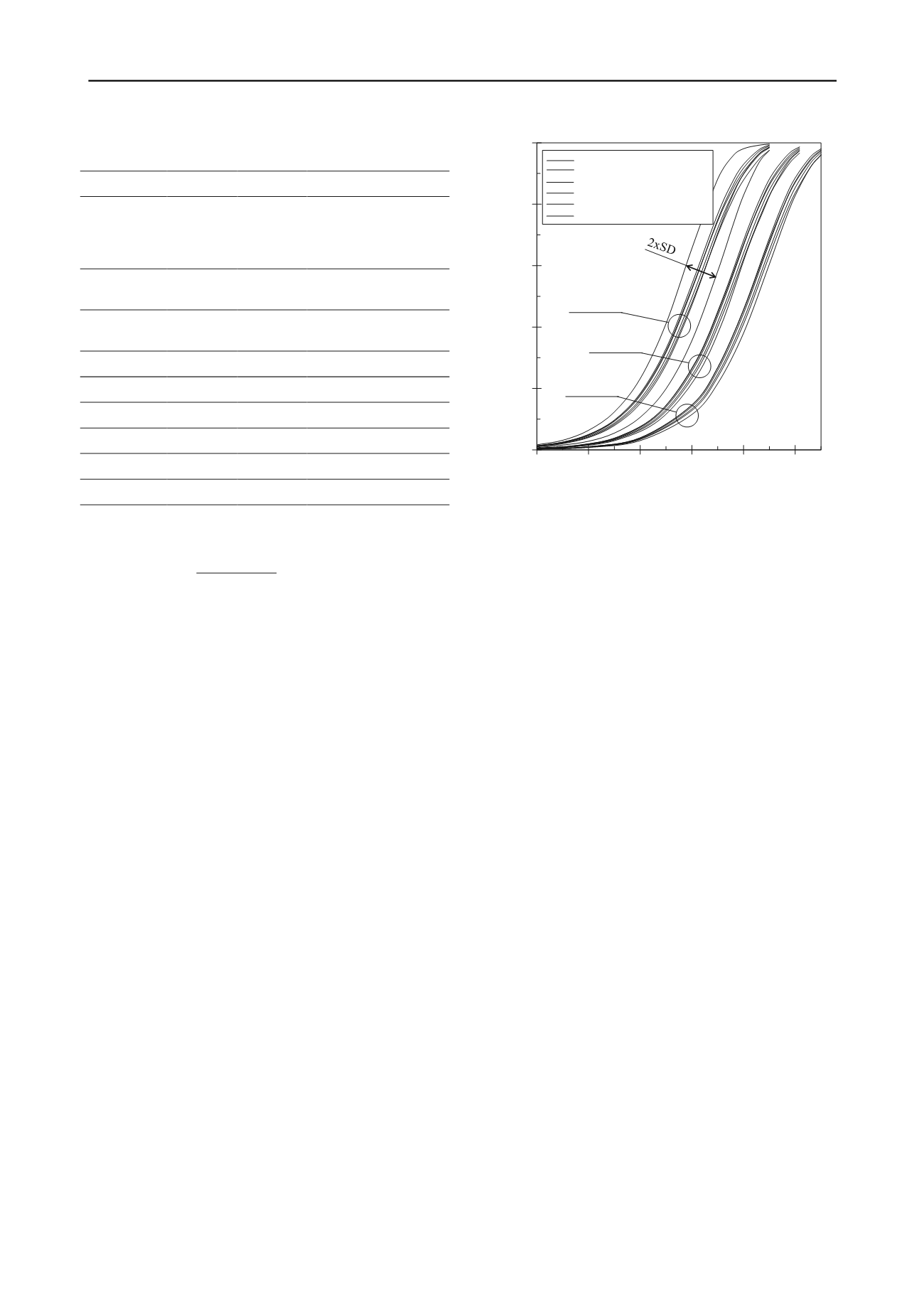
2967
Technical Committee 214 /
Comité technique 214
Proceedings of the 18
th
International Conference on Soil Mechanics and Geotechnical Engineering, Paris 2013
2.2
The influences of the variables on the assessments of U
The influences of the variables
and
(Eq. 2) are shown vs.
assessed values of
in Figure 3 for
1.6 metres. The
appearance is similar for the other two values of
. In models I,
II, IV, V and VI, the influences of the other variables were
<0.045 for all values on
. However, formodel III, the
influences of
⁄
and
⁄
were equal to that of
, so that
the curves for
p/
i
and
Cc/Ck
coincide with the curve for
(the short-dashed curve). Model I was excluded from this
figure, as
was equal to 1 for all values of
. In the figure, it
can be seen that
0.8 for
0.8, whereafter
decreases
rapidly and
(and in case III also
p/
i
and
Cc/Ck
) become
progressively more influential.
2.3
The
variables’
contribution to
In Figure 4, the relative influences of the four variables treated
stochastically on
are shown for
1.6 metres. The
appearance is similar for the other two values of
. It can be
seen that
contributes more than 50% to
in all the
analyses, that
accounts for most of the remainder and
that the contributions from
and
⁄
are smaller.
3 DISCUSSION
3.1
Values on the variables
The values assigned to the variables in the analyses were chosen
by the present authors based on suggestions in the literature and
are considered to be representative for soft clays. In the
framework of this study (results not presented),
for the
variables were varied within reasonable ranges one at a time
rendering a similar appearance in the results to that presented.
Other combinations of the variables might render results that
deviate from the results presented here, but it is the authors
’
belief that the appearance of the results is typical for most cases.
3.2
The assessed U and the influences of the variables
As seen in Figure 2, model I followed by model II were the
most conservative, predicting the slowest consolidation rate.
Comparing the formulations for
in model II with those in
models IV-VI (Figure 1b and Table 1), this is obvious since
model II assigns a constant value of
over
whereas
is
successively increased in the other three models. In this context,
it should be noted that model III gives lower values of
than
model II at corresponding
for
⁄
1 (0.75 in this study).
The finding that model I was the most conservative emphasises
the relative importance of
compared to the modelling of the
smear zone. Model I does not take the smear zone into account
but adopts
instead of
(
was assumed to be 1.5 times less
than
in this study). The relative importance of
is also
shown in Figure 3 where
predominates in the assessment of
for all but the last parts of the consolidation sequences.
The significance of (re)consolidation effects and the
associated decrease in
(incorporated in model III) is
confirmed by the results of laboratory oedometer tests presented
by Indraratna and Redana (1998), Sharma and Xiao (2000) and
Sathananthan and Indraratna (2006). The results presented in
their studies suggest that the resulting decrease in void ratio
when the consolidation stresses are increased by 25-50 kPa lead
to a more pronounced decrease in
than the disturbance
induced by the installation process. Hence, in most cases it is
more important to consider the change in
that occurs due to
the decrease in void ratio during consolidation than the
disturbance effects.
3.3
The uncertainty in U
To reduce the uncertainty in the assessment of
via any of the
investigated models, it is obvious that attention should be
directed primarily towards
, since the uncertainty in
is
dependent on
via
⁄
, and
secondarily towards
(Figure 4). Hence, site investigations
intended for the design of PVDs should focus on reducing the
level of uncertainty in
and possibly the degree of disturbance
in the smear zone (i.e.
).
In ordinary engineering projects involving clay, investigations
of
(e.g. via oedometer tests) are far more frequent than
investigations of
and it might therefore be worth considering
model I. However, if model I is used for design purposes, care
must be taken as
is used instead of
Table 2. Values assigned to the variables in the analyses,
is the
average value and
is the coefficient of variation
Variable
Comment
5x10
-8
m
2
/s
A
0.35
considered
representative for soft
clays and
chosen
based on Lumb (1974)
0.066
m
B
Det.
Rectangular PVD
0.003 m x 0.1 m
⁄
1.7
B
Det.
Rectangular mandrel
0.06 m x 0.12 m
⁄
4.7
0.34
C
8
0.34
⁄
⁄
1.6
0.34
C
⁄
2
Det.
Arbitrary chosen
⁄
0.75
0.34
D
arbitrary chosen
2
Det.
C
A
5x10
-8
/1.5=3.3x10
-8
m
2
/s for model I
B
Equivalent diameter evaluated as proposed by Hansbo (1979)
C
and
evaluated from the cited laboratory tests
D
√
where
0.3 (Lumb 1974)
and
0.15 (from compilation in Müller and Larsson 2012)
Figure 2.
assessed via the six models for different values of
.
0
0.2
0.4
0.6
0.8
1
1
4
16
64 256 1024
U
(-)
t
(days)
d
= 1.1 m
d
= 2.1 m
d
= 1.6 m
Kjellman (1949), I
Hansbo (1979), II
Indraratna et al. (2005), III
Walker & Indraratna (2006), IV
Basu et al. (2006)-b, V
Basu et al. (2006)-d, VI


